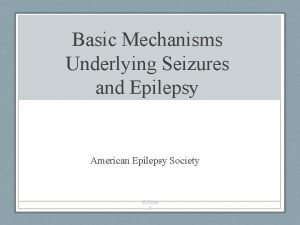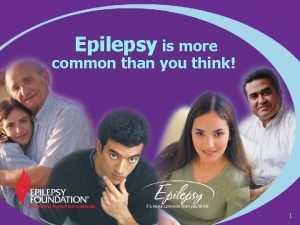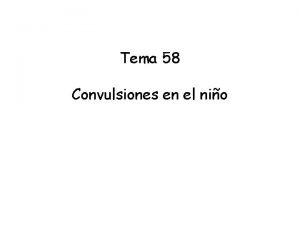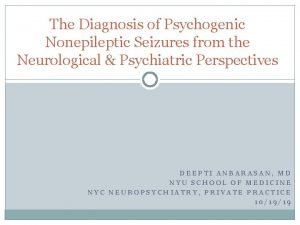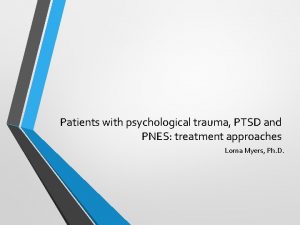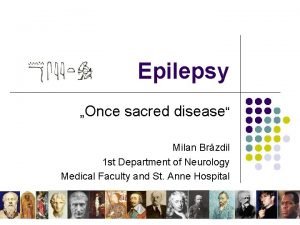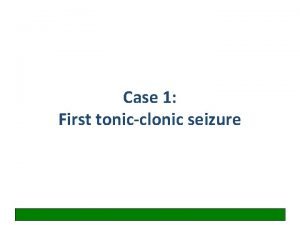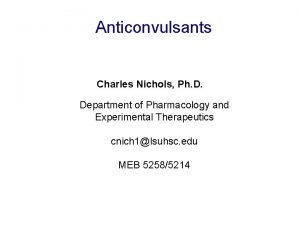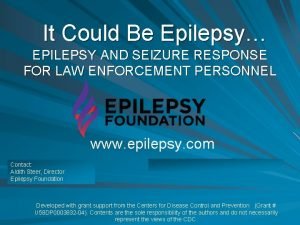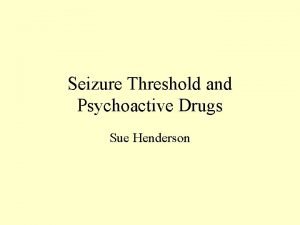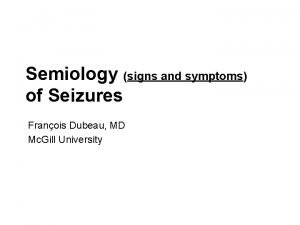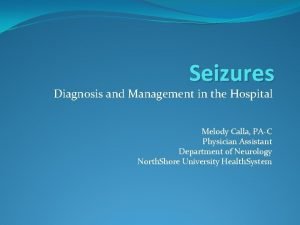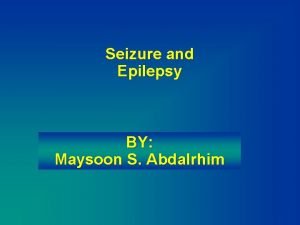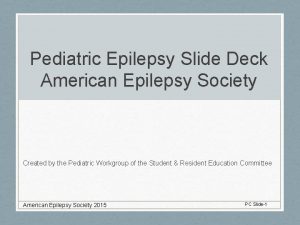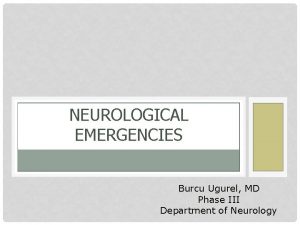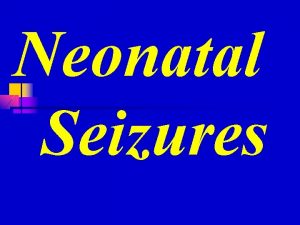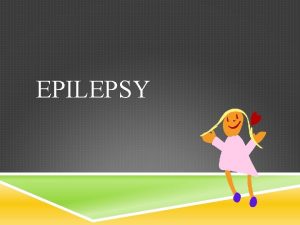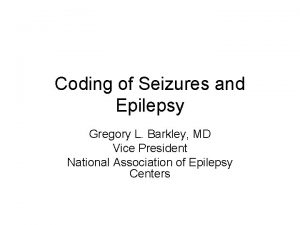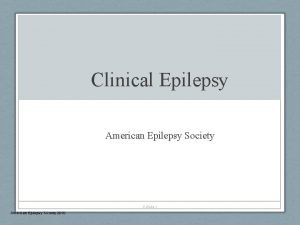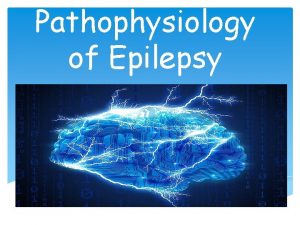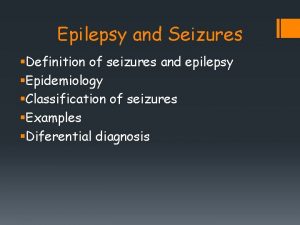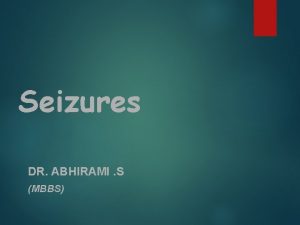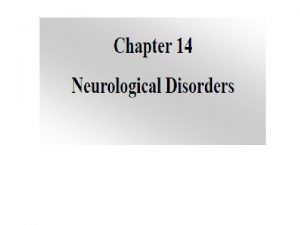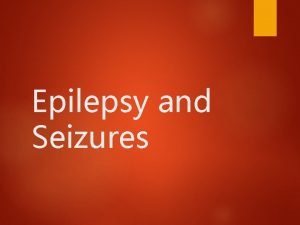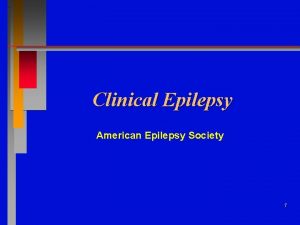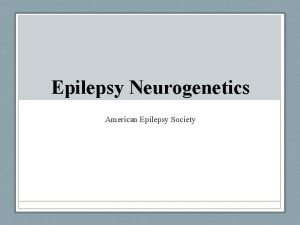Pathophysiology of Epilepsy Seizures Epilepsy Definition Seizure Convulsion

































- Slides: 33

Pathophysiology of Epilepsy

Seizures Epilepsy

Definition Seizure (Convulsion) • Clinical manifestation of synchronised electrical discharges of neurons Seizures are symptoms of a disturbance in brain function , which can be due to epilepsy or other causes A seizure is a sudden surge in electrical activity in the brain that causes an alteration in sensation, behavior, or consciousness


Epilepsy Present when 2 or more unprovoked seizures occur at an interval greater than 24 hours apart Sudden recurrent episodes of sensory disturbance Loss of consciousness, or convulsions Associated with abnormal electrical activity in the brain

Abnormal , excessive electrical discharge of a group of neurons within the brain. When a person has recurrent ( 2 or more) , unprovoked seizures “ epileptic “. Hence seizures can be a symptom of epilepsy


Definition Provoked seizures Seizures induced by somatic disorders originating outside the brain E. g. fever, infection, syncope, head trauma, hypoxia, toxins, cardiac arrhythmias


Seizures Partial or Generalized

a. Simple partial seizures manifest motor, somatosensory, and psychomotor symptoms without impairment of consciousness b. Complex partial seizures manifest impairment of consciousness with or without simple partial symptoms


c. Generalized seizures manifest a loss of consciousness concvulsive or non-convculsive Generalized seizures include (1) generalized tonic-clonic seizures (Grand Mal epileptic seizure ) (2) Absence seizures (Petit mal epileptic seizures)


Seizure Classification & Clinical Manifestations 1. 2. Focal / Partial seizures their onset ( start) is limited to part of the cerebral hemisphere Generalized seizures those that involve the cerebral cortex diffusely ( whole of it ) from the beginning (generalized seizures)


The onset of a seizures: Small group of abnormal neurons undergo - Prolonged depolarizations - Rapid firing of repeated action potentials Spread to adjacent neurons or neurons with which they are connected into the process.

A clinical seizure occurs when the electrical discharges of a large number of cells become abnormally linked together, creating a storm of electrical activity in the brain. Seizures may then spread to involve adjacent areas of the brain or through established anatomic pathways to other distant areas.

Generalized 1 - Generalized tonic-clonic (grand mal) seizure a. +/- aura (peculiar sensation or dizziness; then sudden onset of seizure with loss of consciousness) tonic phase : Rigid muscle contraction in which clenched jaw and hands; eyes open with pupils dilated; lasts 30 to 60 seconds clonic phase: Rhythmic, jerky contraction and relaxation of all muscles in with incontinence and frothing at the lips; may bite tongue or cheek, lasts several minutes. postictal state: Sleeping or dazed for up to several hours.


Generalized 2. Absence ( petit mal) seizure a. Loss of contact with environment for 5 to 30 seconds. b. Appears to be day dreaming or may roll eyes, nod head, move hands, or smack lips. c. Resumes activity and is not aware of seizure.

The clinical manifestations of a seizure reflect the area of the brain from which the seizure begins (i. e. , seizure focus) and the spread of the electrical discharge.

Clinical manifestations accompanying a seizure are numerous and varied, including (1) indescribable bodily sensations, (2) "pins and needles" sensations, (3) smells or sounds, (4) fear or depression, (5) hallucinations, (6) momentary jerks or head nods, (7) staring with loss of awareness, and (8) Convulsions i. e. , involuntary muscle contractions) lasting seconds to minutes.


Aetiology of seizures § Epileptic § § Idiopathic (70 -80%) Cerebral tumor Neurodegenerative disorders Secondary to § Cerebral damage: e. g. congenital infections, intraventricular hemorrhage § Cerebral dysgenesis/malformation: e. g. hydrocephalus

Aetiology of seizures § Non-epileptic § Febrile convulsions § Metabolic § Hypoglycemia § Hypo. Ca, Hypo. Mg, Hyper. Na, Hypo. Na § § Head trauma Meningitis Encephalitis Poisons/toxins

Pathophysiology of Epilepsy ( at molecular level) • Cortical cell membrane level Ø Instability of the nerve cell membrane Polarization abnormalities (excessive polarization , hypopolarization , or lapses in repolarization), allowing the cell to be more susceptible to activation Hypersensitive neurons with lowered thresholds for firing and firing excessively , related to

§ (1) Excess of Excaitatory ( acetylecholine- or Glutamate – related activity ) § (2) Decreased inhibitory ( GABA –related activity) Ø Together and/or (2) above leading to instability of cellmembrane & lowered threshold for exciatation excessive polarization, hypopolarization allowing the cell to be more susceptible to activation spontaneously or by any ionic imbalances in the immediate chemical environment of neurons


Electroencephalogram ( EEG) EEG ›››› diagnosis, classifying seizures ›››› therapeutic decisions spikes or sharp waves (Epileptiform EEG patterns) Ø Focal epileptiform discharges indicate focal epilepsy Ø Generalized epileptiform activity indicates a generalized form of epilepsy.

Some types liked to genes (run in families) Genetic abnormalities ›››› increasing a person's susceptibility to seizures that are triggered by an environmental factor Several types of epilepsy have now been linked to defective genes for ion channels, the "gates" that control the flow of ions in to and out of cells and that regulate neuron signaling.

Pathophysiology Genetic factors At least 20 % Some examples Benign neonatal convulsions--20 q and 8 q Juvenile myoclonic epilepsy--6 p Progressive myoclonic epilepsy--21 q 22. 3

 Basic mechanisms underlying seizures and epilepsy
Basic mechanisms underlying seizures and epilepsy Seizure vs epilepsy
Seizure vs epilepsy Epilepsy and seizure services near sutter creek
Epilepsy and seizure services near sutter creek Difference between seizure and epilepsy
Difference between seizure and epilepsy Convulsion febril
Convulsion febril Febrile convulsion treatment
Febrile convulsion treatment Complex febrile
Complex febrile Non epileptic seizures
Non epileptic seizures Pediatric seizures
Pediatric seizures Ptsd seizures
Ptsd seizures Tremors vs seizures
Tremors vs seizures Psychomotor seizures
Psychomotor seizures Psychomotor seizures
Psychomotor seizures Hemorrhagic irregular tissue fragments
Hemorrhagic irregular tissue fragments Nursing diagnosis of meningitis slideshare
Nursing diagnosis of meningitis slideshare Seizures
Seizures Pimidone
Pimidone What to do if someone is having a seizure
What to do if someone is having a seizure Simple partial seizures vs complex
Simple partial seizures vs complex What is a seizure
What is a seizure Seizure threshold meaning
Seizure threshold meaning Status asthmaticus pathophysiology
Status asthmaticus pathophysiology X ray of asthma patient
X ray of asthma patient Sv times hr
Sv times hr Ictal meaning
Ictal meaning Seizure vs syncope
Seizure vs syncope Seizure precautions bed rails
Seizure precautions bed rails Hypsarrhythmia eeg
Hypsarrhythmia eeg Bradynpea
Bradynpea Difference between jitteriness and seizure
Difference between jitteriness and seizure Warning signs of a seizure
Warning signs of a seizure Seizure precautions bed rails
Seizure precautions bed rails Breakthrough seizure
Breakthrough seizure Syncope vs seizure
Syncope vs seizure
